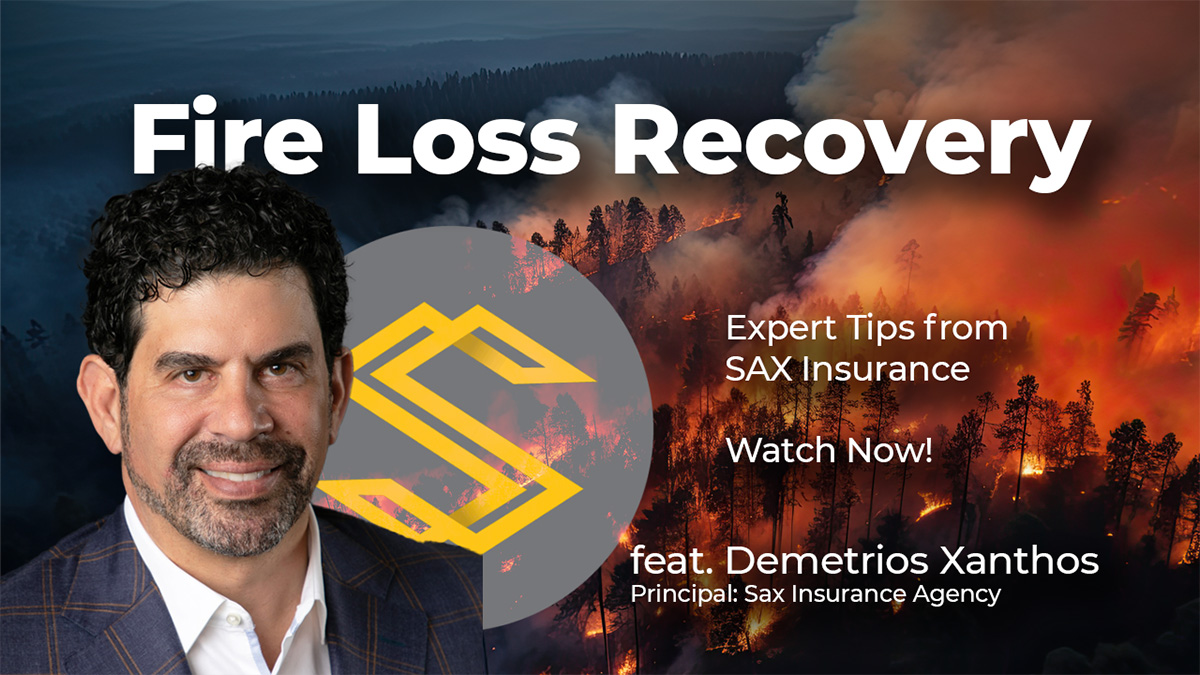At SAX Insurance, we understand the profound impact that wildfires can have on homeowners, condominium associations, and entire communities. Following the devastating wildfires in California, SAX Insurance, led by Principal and CEO Demetrios Xanthos, participated in a webinar hosted by HOA Organizers to provide critical guidance for those affected. This blog post distills the key insights shared by Demetrios and fellow panelists: Russell Brown, CEO of the G.B. Group, and Michael Kennedy, a partner at Berding & Weil, to help homeowners and HOA board members navigate the complex process of recovery after a fire loss. Whether you’ve experienced a total loss, partial damage, or are preparing for future risks, this comprehensive guide offers actionable steps and expert advice to support your recovery journey.
Understanding the Immediate Steps After a Fire Loss
Filing Insurance and FEMA Claims: Act Quickly
One of the most critical steps following a fire loss is to promptly file claims with both your insurance carrier and the Federal Emergency Management Agency (FEMA). As Demetrios Xanthos emphasized, “The first thing you have to do is contact the agent, as well as make sure that the claims process is underway.” This applies to single-family homeowners, condo unit owners, and HOA board members. Filing claims early ensures you are among the first to get the attention of adjusters, who may be handling hundreds of claims during a disaster.
Key Actions:
- Contact Your Insurance Agent Immediately: Notify your carrier of the loss to initiate the claims process. Request a full certified copy of your policy, not just the declarations page, to understand your coverage fully.
- File a FEMA Claim: Visit disasterassistance.gov or use the FEMA app to apply for assistance. FEMA can help cover shortfalls in insurance coverage, such as insufficient property damage or relocation expense coverage.
- Document Everything: Keep detailed records of all communications with adjusters, including claim numbers, and gather evidence of losses (e.g., photos, receipts, or family photos showing possessions).
Demetrios highlighted the importance of a two-pronged approach: “You want to file with your insurance carrier, and you want to open a FEMA claim because what will happen is depending on if there are any shortfalls in your coverages… FEMA should be able and hopefully able to step in and cover that shortfall.” Even if you receive a “not approved for assistance” letter from FEMA, don’t be discouraged. Provide additional documentation, such as proof of insurance settlements or denials, to appeal the decision.
Practical Steps for Homeowners
Michael Kennedy stressed the importance of practical measures to manage the aftermath of a fire:
- Secure a PO Box: If your home is inaccessible, set up a PO Box to receive mail.
- Turn Off Utilities: Cancel services like landlines or landscaping that are no longer needed to avoid unnecessary costs.
- Request Advance Payments: Ask your insurance adjuster for advance payments for living expenses if you’re displaced from your home.
Addressing Total and Partial Losses
Total Loss: What to Do
For those who have suffered a total loss, the process can feel overwhelming. Russell Brown, a reconstruction expert, offered heartfelt condolences and practical advice: “From a construction standpoint, the short answer is that initially, this will go as fast as you can get the insurance claim filed and get it moving.” He recommended proactive steps to expedite the process:
- Obtain Bids: Gather multiple bids from contractors to support your insurance claim and speed up the adjustment process.
- Reassess Property Taxes: Visit the county assessor’s office to have your property revalued, as you shouldn’t pay taxes on a structure that no longer exists.
- Coordinate with Authorities: Be patient, as city and county infrastructure repairs (e.g., water, sewage, and power) must be completed before rebuilding can begin.
Demetrios added that FEMA can be a critical resource for total losses, especially for those without insurance or with inadequate coverage: “If you are someone that had no insurance… you definitely want to file a claim with FEMA and seek full recovery of not only your premise, your property, your loss of use, your loss of possibly income.”
Partial Losses: Smoke and Soot Damage
For properties with smoke or soot damage, filing a claim is still advisable. Demetrios noted, “Smoke damage, soot, etc., because it’s a byproduct of fire, will be covered.” However, he cautioned that many HOAs have shifted to per-unit deductibles due to the high cost of remediating smoke and soot damage across multiple units.
Russell advised a thorough inspection: “Do a thorough inspection of your building and your home. Look behind appliances, check outlets for brownouts, and examine plumbing.” He recommended hiring a contractor to assess hidden damage, as issues like microscopic particles from burned materials can degrade construction materials over time. For peace of mind, consider an air clearance test, which costs $500–$1,000 and can confirm air quality safety.
Michael Kennedy emphasized the seriousness of remediation: “It’s not just cleaning and painting. It’s a pretty serious thing that really needs to be remediated.” Smoke blockers and specialized paints may be necessary to encapsulate odors and chemicals.
Insurance Challenges and Market Trends
Rising Premiums and Cancellations
The insurance market in California has been challenging, with carriers facing significant losses—$60 billion collectively in 2022 and 2023, according to Demetrios. The recent wildfires, potentially exceeding $100 billion in losses, may exacerbate this trend, leading to higher premiums, increased deductibles, and more policy cancellations. Demetrios explained, “Insurance companies are a large boat turn slow… Their attempt to change their underwriting appetite… was an attempt to get profitable again.”
What to Expect:
- Higher Deductibles: Carriers are moving toward per-unit deductibles, especially for HOAs, to manage risks like smoke and soot damage.
- Policy Cancellations: If you receive a cancellation notice, confirm the timing. As Michael noted, “If the policy was in effect at the time of the loss, you’re still covered,” even if canceled later.
- Layered Coverage: For large condo complexes, multiple carriers may share the risk, with each covering a portion of the total exposure.
Demetrios offered hope: “We were starting to see a little bit of relief… What I don’t know is… this loss here is probably going to set us back.” He suggested that 2027 might bring some normalcy, but carriers will closely monitor their performance in 2025 and 2026.
Strategies for Securing Coverage
To improve insurability, Demetrios advised HOAs to focus on modern, well-maintained properties: “The hottest spot that insurers want to ensure are buildings built in the last 20 years that are fully sprinklered and have flame-retardant materials.” Associations with updated roofs, electrical panels, and proper reserves are more likely to secure favorable rates. For older properties, non-admitted carriers may be the only option, often at higher costs.
Michael recommended reviewing HOA governing documents: “If the CC&Rs require full replacement value insurance that’s impossible to obtain, consider amending them to reflect market realities.” Boards should work with legal counsel to ensure compliance and avoid liability.
Rebuilding and Infrastructure Considerations
Rebuilding Timeline
Russell estimated that rebuilding a single-family home takes about one year with a clear permit, while a quadplex may take 14–16 months. However, infrastructure repairs (e.g., water, power, sewage) could take 6–10 months, with full recovery potentially spanning 7–10 years, based on the Napa fires’ timeline. He advised, “The speed of when your unit will be restored… is the speed that you can get through the insurance claim adjustment process and get a building permit.”
Fire-Resistant Construction
To enhance insurability, Russell highlighted the use of fire-resistant materials like intumescent paint and sprinklers, which are becoming standard in new builds. Demetrios noted that FEMA can cover increased costs due to building code upgrades, such as switching to steel studs, if insurance falls short.
Avoiding Price Gouging
With rising material costs and potential price gouging, Russell recommended obtaining multiple bids and negotiating fixed-fee contracts with clear terms for material cost increases. He offered, “If you would like my company to take a quick look at a quote… we could probably extend that resource to you.”
FEMA’s Role in Recovery
FEMA is a critical resource for both individuals and HOAs. Demetrios emphasized, “It doesn’t matter whether you have insurance, a non-admitted carrier,sketchy, or no insurance—file a FEMA claim.” FEMA can cover:
- Property damage not fully covered by insurance.
- Relocation expenses if insurance runs out.
- Loss of use or income due to displacement.
HOAs can file claims for association-wide losses, such as common area damage, while individuals can claim personal property losses. Even if initially denied, appeals with proper documentation can overturn decisions.
Legal and Financial Considerations
HOA Assessments
Michael addressed concerns about HOA dues post-disaster: “The assessments levied by the association have to be paid… but the board could decide to lower them” if certain services (e.g., landscaping) are unnecessary during rebuilding. Boards should consult legal counsel before altering assessments or reallocating emergency funds.
Special Assessments
For associations with leftover emergency assessment funds, Michael advised reviewing the resolution authorizing the assessment and consulting HOA counsel. Options include saving funds for future reconstruction or holding a town hall to gauge member opinions, ensuring all members are treated equally.
Practical Tips for Recovery
- Inventory Personal Possessions: Create a detailed inventory with photos and replacement costs. Even family photos can serve as evidence if receipts are unavailable.
- Hire Qualified Contractors: For cleanup, hire licensed professionals to avoid damaging structures or health risks from toxic materials.
- Stay Informed: Monitor updates from state and local authorities, as permitting processes may be streamlined to expedite rebuilding.
SAX Insurance: Your Partner in Recovery
At SAX Insurance, we are committed to supporting our clients through every step of the recovery process. With Demetrios Xanthos’s expertise across 11 states, we provide tailored guidance for homeowners and HOAs navigating the complexities of fire loss claims. Fill in the form below to learn more about our services or contact us at [insert contact info] for personalized assistance.
Conclusion
Recovering from a wildfire is a daunting task, but with prompt action, expert guidance, and resources like FEMA, homeowners and HOAs can rebuild stronger and more resilient communities. SAX Insurance, alongside industry partners like HOA Organizers, is dedicated to providing the tools and support needed to navigate this challenging time. Stay proactive, file claims early, and lean on professionals to ensure a fair and efficient recovery process.
For additional resources, visit disasterassistance.gov and join our upcoming webinars for the latest updates. Together, we can rebuild and recover.



